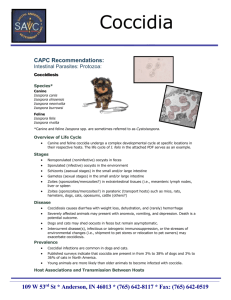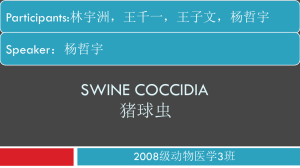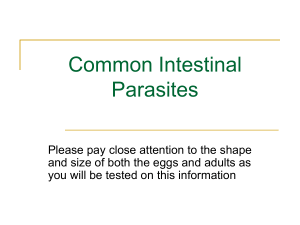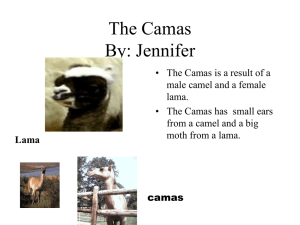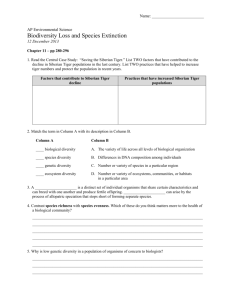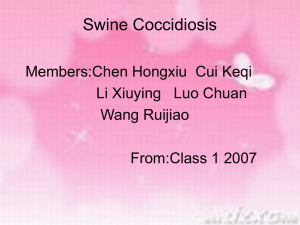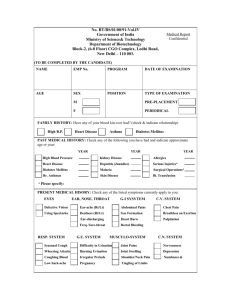Phylogenetic position analysis of an Isospora isolated from Siberian
advertisement
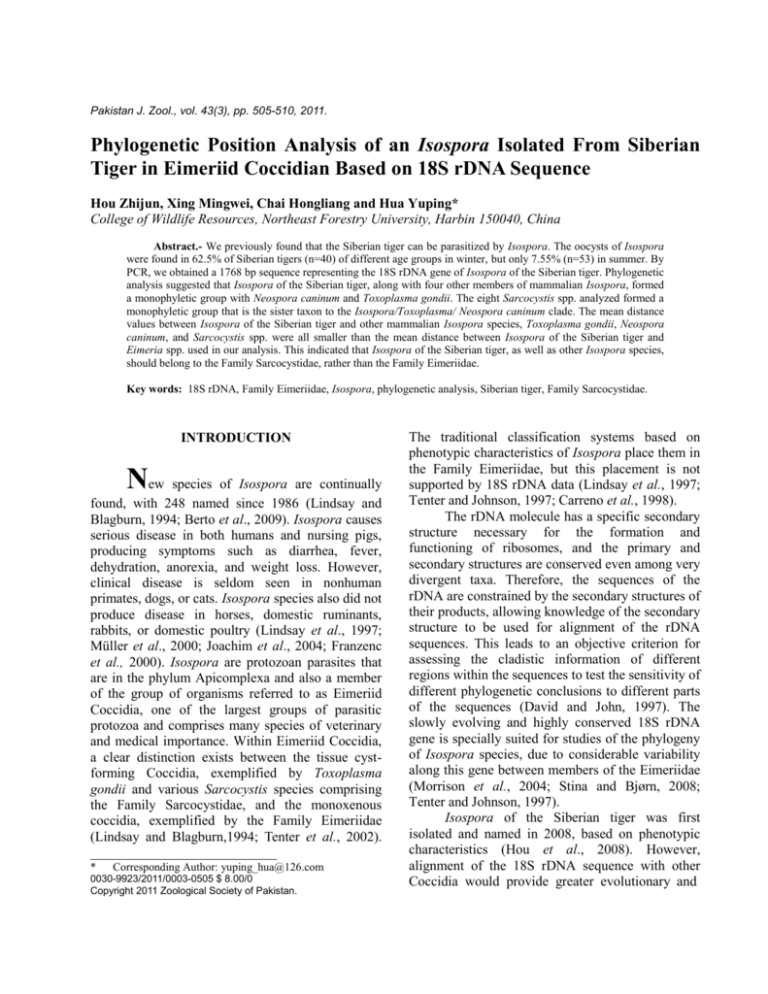
Pakistan J. Zool., vol. 43(3), pp. 505-510, 2011. Phylogenetic Position Analysis of an Isospora Isolated From Siberian Tiger in Eimeriid Coccidian Based on 18S rDNA Sequence Hou Zhijun, Xing Mingwei, Chai Hongliang and Hua Yuping* College of Wildlife Resources, Northeast Forestry University, Harbin 150040, China Abstract.- We previously found that the Siberian tiger can be parasitized by Isospora. The oocysts of Isospora were found in 62.5% of Siberian tigers (n=40) of different age groups in winter, but only 7.55% (n=53) in summer. By PCR, we obtained a 1768 bp sequence representing the 18S rDNA gene of Isospora of the Siberian tiger. Phylogenetic analysis suggested that Isospora of the Siberian tiger, along with four other members of mammalian Isospora, formed a monophyletic group with Neospora caninum and Toxoplasma gondii. The eight Sarcocystis spp. analyzed formed a monophyletic group that is the sister taxon to the Isospora/Toxoplasma/ Neospora caninum clade. The mean distance values between Isospora of the Siberian tiger and other mammalian Isospora species, Toxoplasma gondii, Neospora caninum, and Sarcocystis spp. were all smaller than the mean distance between Isospora of the Siberian tiger and Eimeria spp. used in our analysis. This indicated that Isospora of the Siberian tiger, as well as other Isospora species, should belong to the Family Sarcocystidae, rather than the Family Eimeriidae. Key words: 18S rDNA, Family Eimeriidae, Isospora, phylogenetic analysis, Siberian tiger, Family Sarcocystidae. INTRODUCTION New species of Isospora are continually found, with 248 named since 1986 (Lindsay and Blagburn, 1994; Berto et al., 2009). Isospora causes serious disease in both humans and nursing pigs, producing symptoms such as diarrhea, fever, dehydration, anorexia, and weight loss. However, clinical disease is seldom seen in nonhuman primates, dogs, or cats. Isospora species also did not produce disease in horses, domestic ruminants, rabbits, or domestic poultry (Lindsay et al., 1997; Müller et al., 2000; Joachim et al., 2004; Franzenc et al., 2000). Isospora are protozoan parasites that are in the phylum Apicomplexa and also a member of the group of organisms referred to as Eimeriid Coccidia, one of the largest groups of parasitic protozoa and comprises many species of veterinary and medical importance. Within Eimeriid Coccidia, a clear distinction exists between the tissue cystforming Coccidia, exemplified by Toxoplasma gondii and various Sarcocystis species comprising the Family Sarcocystidae, and the monoxenous coccidia, exemplified by the Family Eimeriidae (Lindsay and Blagburn,1994; Tenter et al., 2002). ___________________________ * Corresponding Author: yuping_hua@126.com 0030-9923/2011/0003-0505 $ 8.00/0 Copyright 2011 Zoological Society of Pakistan. The traditional classification systems based on phenotypic characteristics of Isospora place them in the Family Eimeriidae, but this placement is not supported by 18S rDNA data (Lindsay et al., 1997; Tenter and Johnson, 1997; Carreno et al., 1998). The rDNA molecule has a specific secondary structure necessary for the formation and functioning of ribosomes, and the primary and secondary structures are conserved even among very divergent taxa. Therefore, the sequences of the rDNA are constrained by the secondary structures of their products, allowing knowledge of the secondary structure to be used for alignment of the rDNA sequences. This leads to an objective criterion for assessing the cladistic information of different regions within the sequences to test the sensitivity of different phylogenetic conclusions to different parts of the sequences (David and John, 1997). The slowly evolving and highly conserved 18S rDNA gene is specially suited for studies of the phylogeny of Isospora species, due to considerable variability along this gene between members of the Eimeriidae (Morrison et al., 2004; Stina and Bjørn, 2008; Tenter and Johnson, 1997). Isospora of the Siberian tiger was first isolated and named in 2008, based on phenotypic characteristics (Hou et al., 2008). However, alignment of the 18S rDNA sequence with other Coccidia would provide greater evolutionary and 506 H. ZHIJUN ET AL. Table I.- DNA sequence of primers used for amplification and sequencing of the 18S rDNA gene from Isospora isolated from Siberian tigers. Primer name 1-373 (373bp) 171-530 (360bp) 505-1092 (588bp) 1055-1768 (714bp) Table II.- Orientation Primer sequence Annealing temperature Forward Reverse Forward Reverse Forward Reverse Forward 5’-TCTGGTTGATCCTGCCAGTAGT-3’ 5’-CTAATTCCCCGTTACCCGTCAC-3’ 5’-CGCACATGCCTCTTTCTCAG-3’ 5’-GGTTTGGATTCCCATCATTC-3’ 5’-TGATTGGAATGATGGGAATCC-3’ 5’-CTTG ATTCCTCATGGTGCAGG-3’ 5’-CGTCATACTTGACTTCTCCTGCAC-3’ Reverse 5’-CGGAAACCTTGTTACGACTTCTCC-3’ 53.6℃ 55.6℃ 53.0℃ 56.7℃ GenBank accession numbers of organisms used for phylogenetic analysis. Organisms GenBank accession number Sarcocystis hirsute S. fusiformis S. gigantea S. scandinavica S. arieticanis S. crizi S. alceslatrans Toxoplama gondii Neospora caninum Isospora orlovi I. belii AF017121 U03071 L24384 EU282032 L24382 AF017120 EU282033 M97703 U03069 AF365026 U94787 taxonomic information. Therefore, the goals of this study were to determine the interrelationship of Isospora of the Siberian tiger within eimeriid coccidia, as well as its phylogenetic position relative to other Eimeriid Coccidia, based on 18S rDNA gene sequence data by a wide range of tree building methods for evolutionary modeling strategies. MATERIALS AND METHODS Organism Oocysts of Coccidia were obtained by floatation from feces of naturally infected Siberian tigers located in Harbin, Heilongjiang province, China (45° 82′ N; 126° 60′ E). Fecal samples were collected from tigers of different age groups housed in single cages and fed beef or chicken. Samples were collected after defecation, placed into plastic bags, and transported immediately to the laboratory. Organisms I. suis Isospora of Siberian tiger I. felis Eimeria necatrix E. tenella Cyclospora cayetanesis E. nieschellzi I. robini Caryospora bigeretica Lankesterella minima Cryptosporidium parvum GenBank accession number U97523 FJ35779 L76471 U67119 U67121 U40261 U40263 AF080612 AF060976 AF080611 L16996 Sporulation and sequence Sporulation and DNA extraction was performed according to the methods described by Hou et al. (2008). Four pair primers (Table I) for PCR were designed to amplify four fragments of the 18S rDNA of Isospora of the Siberian tiger. Procedures for avoiding contamination were strictly followed, and negative (no-DNA) and positive (Toxoplasma gondii DNA) controls were included in every trial. Amplifications were performed in 25μl reaction mixtures consisting of the following: 100 pmol of each primer, 200 μM each deoxynucleoside triphosphate (dNTP), 10 mM TrisHCl (pH 8.3), 50 mM KCl, 1.5 mM MgCl2, and 2.5 U of Taq DNA polymerase (Takara, Japan) in the appropriate buffer. Reactions were run in a Takara thermocycler using a step-cycle program. Cycling conditions comprised an initial denaturation of DNA at 94° for 5 min, followed by 35 cycles of 94° for 30 s, each annealing temperature for 30 s, and 72° for 1 PHYLOGENETIC POSITION ANALYSIS OF AN ISOSPORA ISOLATED FROM SIBERIAN TIGER min, and a final 10 min 72° extension step. The PCR products were cloned using the TaKaRa Agarose Gel DNA Purification Kit Ver.2.0 (TaKaRa) and sequenced directly by Invitrogen Company. Phylogenetic analysis Based on taxonomic position, biology, and morphology, a set of Coccidia species was selected to cover the biodiversity of Sarcocystidae and Eimeriidae, and Cryptosporidium parvum was used as an outgroup. The sequences were obtained from GenBank (accession numbers shown in Table II). The beginning and end of some of the aligned sequences were truncated to match those that were less sequenced. The 18S rDNA sequence obtained from Isospora of the Siberian tiger was aligned with those sequences from Coccidia using Clustal X (version 1.81). Multiple alignment parameters were as follows: gap open penalty 15, gap extension penalty 6.66, transition weight 0.5, and delay divergent sequence 30%. The alignment file was analyzed and phylogenetic trees were constructed by different algorithms, including maximum parsimony (DNAPARS), compatibility (DNACOMP), maximum likelihood (DNAML), and distance methods (DNADIST, Neighbor-Joining, and FitchMargoliash) from the PHYLIP package, version 3.69, and maximum parsimony, minimum evolution, and Neighbor-Joining from the MEGA package, version 4.0.2. Pairwise distances between taxa were calculated using Kimuras two-parameter method (MEGA). Bootstrap values were calculated for all tree-building methods and were obtained from 100 resamplings. Consensus trees were calculated in CONSENSE (PHYLIP). database (accession number FJ357797). No amplification product was detectable in the negative or positive controls. The two main clades resulting from our analysis correspond in most respects to the taxa sampled from the cyst-forming coccidia (A) and the intestinal oocyst-forming coccidia (B), which comprise the currently recognized families Sarcocystidae and Eimeriidae, respectively. Phylogenetic analysis suggested that Isospora of the Siberian tiger, along with four additional members of mammalian Isospora, form a monophyletic group with Neospora caninum and Toxoplasma gondii. The eight Sarcocystis spp. analyzed form a monophyletic group that was the sister taxon to the Isospora/Toxoplasma/Neospora caninum clade (Fig.1). By using different algorithms, trees of nearly identical topology were computed. In all trees found, Isospora spp., together with Neospora caninum and Toxoplasma gondii, formed a sister group to the Sarcocystis spp. There were no cases suggesting that Isospora of the Siberian tiger, or any other member of mammalian Isospora, are more closely related to members of the family Eimeriidae. RESULTS Isospora oocysts were found in 62.5% of Siberian tigers (n=40) of different age groups in winter, while 7.55% (n=53) in summer. Amplification of DNA from Isospora of Siberian tigers with the four primer pairs produced DNA fragments of 373 bp, 360 bp, 588 bp, and 714 bp. We deleted the overlap sequences between the four fragments and obtained a 1768 bp sequence representing the 18S rDNA gene of Isospora. This sequence has been deposited in the GenBank 507 Fig. 1. Neighbor-Joining tree (left) was found by distant method (MEGA). Horizontal distances show the number of nucleotide changes, and vertical distances have no meaning. Maximum likelihood tree (right) was found by DNAML (PHYLIP), the branch lengths are arbitrary. Numbers on the tree indicate the percentage of bootstrap replicates containing that topology. 508 H. ZHIJUN ET AL. Those results are supported by the distance values shown in Table III. The mean distances values between Isospora of the Siberian tiger and T. gondii and N. caninum were 0.0158 and 0.0028, respectively. Further, mean distance values between Isospora of the Siberian tiger and other mammalian Isospora species or Sarcocystis species were all smaller than 0.0071 and 0.0554, respectively, which was smaller than the mean distance values between Isospora of the Siberian tiger and all Eimeria species (0.0950-0.1517) used in our analysis. DISCUSSION While the taxonomic position of Eimeriid Coccidia at suprafamilial levels is relatively consistent in traditional classifications of protozoa, their classification into families, subfamilies, and genera has been inconsistent for many years (Tenter and Johnson, 1997). The Eimeriid Coccidian that produced sporulated oocysts contains two sporocysts, each with four sporozoites. This group comprises the medically important genera Isospora, Neospora, Sarcocystis, and Toxoplasma. Although there is general agreement on the placement of those coccidia into the suborder Eimeriina, their classification into the families Sarcocystidae and Eimeriidae has not generally been accepted (Tenter et al., 2002; Morrison et al., 2004). Based on our phylogenetic analysis of the eimerrid coccidia, we suggest that the genus Isospora including Isospora of the Siberian tiger should place into the Family Sarcocystidae instead of the Family Eimeriidae. We further suggest that the Coccidia isolated from the Siberian tiger is a species of Isospora, rather than a species of Sarcocystis, because it robustly forms part of a clade with other mammalian Isospora species and a sister group of the Sarcocystis spp.. Hou et al (2008) reported that oocysts collected from the feces of Siberian tigers are ellipsoid, 39.8 (33–47) ×45.5 (39–51) μm, with a shape-index (length/width) of 1.14. The micropyle, oocyst residuum, and polar granules are absent; the wall is a bilayer, with a colorless, thin outer layer and black and brownish inner layer. Oocysts are characterized by having two sporocysts, each containing four sporozoites (Fig. 2). Further, based on oocysts morphology, as well as the morphology PHYLOGENETIC POSITION ANALYSIS OF AN ISOSPORA ISOLATED FROM SIBERIAN TIGER of varied stages incubated in the laboratory, Hou et al. (2008) suggest that the coccidia from the Siberian tiger was Isospora. However, the author did not study the life cycles, epidemiology, and host–parasite relationship of the parasite at the same time. Isospora belli and Isospora suis complete the entire life cycle in a single host, while Isospora felis and Isospora ohioenesis are facultative or heteroxenous and need intermediate hosts to complete their life cycle (Lindsay and Blagburn, 1994; Lindsay et al., 1997; Tenter et al., 2002; Morrison et al., 2004). And we still do not know the life cycle of Isospora of the Siberian tiger. A B C Fig. 2. Microscopic images of coccidia oocysts found in Panthera tigris altaica feces (1000×). A, oocyst having two sporocysts; B, each sporocyst containing four sporozoites; C, one oocyst containing eigh sporazoites. The figure cited from Hou et al. (2008). An accurate classification of unicellular organisms that reflects their natural history is important for the elucidation of unknown life cycles and epidemiological investigations. Consequently, a major problem with their use for reconstruction of phylogenetic relationships is finding those characteristics that are truly homologous among the 509 species (Barta, 1989; Tenter et al., 2002). Molecular phylogenetic analyses based on objective 18S rDNA sequences could provide valuable information on the phylogeny of protozoa, and provide guidance for research on life cycles, biology, and epidemiology, identifying areas of potentially productive future research (Tenter and Johnson, 1997). Although the Siberian tiger is most likely cat, our research indicates that Isospora isolates from the Siberian tiger are more closely related to Isospora suis than Isospra felis (Fig. 1). Therefore, Isospora from the Siberian tiger, like Isospora suis, may be a monoxenous parasite. It has been suggested that Isospora was found to be a polyphyletic genus, life-cycle studies indicate that species with a Stieda body are generally monoxenous and are parasites of birds shows close affinity to the Eimeriidae, while the Isospora species from mammalian hosts, lacking the Stieda and substieda bodies associated with the family Sarcocystidae, were generally heteroxenous (Carreno and Barta,1999; Franzenc et al., 2000; Tentera et al., 2002; Morrison et al., 2004). Our phylogenetic analysis also shows that bird-specific Isospora species, Isospora robini, are placed within the Family Eimeriidae, while other mammalianspecific Isospora species are placed within the Family Sarcocystidae. Many animals may pass Isospora oocysts through their intestine without being a host for the parasite, and the host described for one Isospora species may not be its true natural host. Therefore, the oocysts in the feces of these hosts probably represent pseudoparasites that originated in feed or water contaminated with wild bird feces (Lindsay and Blagburn, 1994). The Siberian tigers we investigated in this study were captive animals, housed in individual cages in the zoo, prohibiting them from coming into contact with other wild birds. Although the tigers were fed chicken, we suggest that the Coccidia isolated were not avian-host species (i.e. a pseudoparasite), but a true Siberian tiger parasite, as it robustly forms part of a clade with other mammalian–specific Isospora species, rather than with bird-specific Isospora species. The life cycle of family Eimeriidae is homoxenous, and the life cycle of the family Sarcocystidae is heteroxenous; the sexual stages 510 H. ZHIJUN ET AL. always develop in the intestine of the definitive host, whereas asexual stages may be present in various tissues of the intermediate hosts, indicating that placement of the mammalian Isospora into family Sarcacysdae is not reasonable. However, it is not known whether Isospora species that are currently believed to be homoxenous might be heteroxenous, thus fitting into the family Sarcocystidae. The Isospora genus has the fewest available 18S rDNA sequences. Therefore, if this phylogeny is to be widely accepted by the field of parasitology, further analysis of Isospora rDNA, as well as phylogenetic analysis, needs to be performed. REFERENCES BARTA, J.R., 1989. Phylogenetic analysis of the class Sporozoea (Phylum Apicomplexa Levine, 1970): evidence for the independent evolution of heteroxenous life cycles. J. Parasitol., 75: 195-206. BERTO, B. P., BALTHAZAR, L. M. C., FLAUSINA, W. AND LOPES, C. W. G., 2009. Three new species of Isospora Schneider, 1881 (Apicomplexa: Eimeriidae) from the buffy-fronted seedeater Sporophila frontalis Verreaux (Passeriformes: Emberizidae) in South America. Syst. Parasitol., 73:65-69. CARRENO, R.A. AND BARTA, J.R., 1999. An eimieriid origin of isosporoid coccidia with stieda bodies as shown by phylogenetic analysis of small subunit ribosomal RNA gene sequences. J. Parasitol., 85:77-83. CARRENO, R.A., SCHNITZLER, B.E., JEFFRIES, A.C., TENTER, A.M., JOHNSON, A.M. AND BARTA, J.R., 1998. Phylogenetic analysis of coccidia based on 18S rDNA sequence comparison indicates that Isospora is most closely related to Toxoplasma and Neospora. J. Eukaryot. Microbiol., 45:184–188. DAVID, A.M. AND JOHN, T.E., 1997. Effects of nucleotide sequence alignment on phylogeny estimation: A case study of 18s rDNAs of Apicomplexa. Mol. Biol. Evol., 14:428-441. FRANZENC, MüLLER, A., BIALEK, R., DIEHL, V., SALZBERGER, B. AND FÄTKENHEUER, G., 2000. Taxonomic position of the human intestinal protozoan parasite Isospora belli as based on ribosomal RNA sequences. Parasitol. Res., 86: 669–676. HOU, Z.J., HUA, Y.P., LIU, J. L., ZENG, X.W. AND CHAI, H.L., 2008. Discovery of Isospora from Panthera tigris altaica. Acta Theriol. Sin., 28:96-100. JOACHIM, A., RUTTOWSKI, B., ZIMMERMANN, M., DAUGSCHIES, A. AND MUNDT, H.C., 2004. Detection of Isospora suis (Biester and Murray 1934) in piglet faeces - comparion of microscopy and PCR. J. Vet. Med. B, 51:140-142. LINDSAY, D. S. AND BLAGURN, B. L., 1994. Biology of mammalian Isospora. Parasitol. Taday, 10:214-220. LINDSAY, D.S., DUBEYJ, P. AND BLAGBURN, B.L., 1997. Biology of Isospora spp. from humans, nonhuman primates, and domestic animals. Clin. Microbiol. Rev., 10:19-34. MORRISON, D.A., BORNSTEIN, S., THEBO, P., WERNERY, U., KINNE, J. AND MATTSSON, G., 2004. The current status of the small subunit rRNA phylogeny of the coccidia (Sporozoa) . Int. J. Parasitol., 34: 501-514. MüLLER, A., BIALEK, R., FäTKENHEUER, G., SALZBERGER, B., DIEHL, V. AND FRANZEN, C., 2000. Detection of Isospora belli by polymerase chain reaction using primers based on small-subunit ribosomal RNA sequences. Eur. J. clin. Microbiol., 19: 631-634. STINA, S.D. AND BJJØM, G., 2008. Sarcocystis in Norwegian roe deer (Capreolus capreolus): molecular and morphological identification of Sarcocystis oviformis n. sp. and Sarcocystis gracilis and their phylogenetic relationship with other Sarcocystis species. Parasitol. Res., 104:993-1003. TENTER, A.M. AND JOHNSON, A.M., 1997. Phylogeny of the tissue cyst-forming coccidia. Adv. Parasit., 39: 69– 139. TENTER, A.M., BARTA, J.R., BEVERIDE, I., DUSZYNSKI, D.W., MEHLHORM, H., MORRISON, D.A., THOMPSON, R.C.A. AND CONRAD, P.A., 2002. The conceptual basis for a new classification of the coccidian. Int. J. Parasitol., 32:595–616. (Received 9 July 2010, revised 9 September 2010) Table III.- Pairwise distance between taxa. Numbers indicate mean distances. 1 Sarcocystis crizi 2 Toxoplamsa gondii 3 S. scandinavica 4 S. arieticani 5 S. alceslatrans 6 S.hirsute 7 S. gigantea 8 Isospora orlovi 9 S. fusiformis 10 Cryptosporidiumparvum 11 Cyclosporacayetanesis 12 Eimeria tenella 13 Caryospora bigeretica 14 E.necatrix 15 I. belii 16 I. felis 17 I. robini 18 I. suis 19 Isosporaof Siberiantiger 20 E. nieschellzi 21 Lankesterella minima 22 Neospora caninum 01 02 03 04 05 06 07 08 09 10 11 12 13 14 15 16 17 18 19 20 21 0.0486 0.0334 0.0136 0.0043 0.0297 0.0305 0.0448 0.0290 0.1407 0.1158 0.1149 0.1115 0.1208 0.0478 0.0524 0.1123 0.0517 0.0478 0.1114 0.1406 0.0493 0.0539 0.0509 0.0486 0.0539 0.0500 0.0158 0.0508 0.1453 0.1042 0.1024 0.0992 0.1082 0.0144 0.0187 0.1016 0.0195 0.0158 0.1024 0.1236 0.0028 0.0320 0.0334 0.0238 0.0275 0.0547 0.0231 0.1468 0.1172 0.1189 0.1104 0.1241 0.0554 0.0593 0.1137 0.0593 0.0554 0.1128 0.1450 0.0539 0.0144 0.0342 0.0327 0.0478 0.0327 0.1478 0.1132 0.1131 0.1098 0.1190 0.0493 0.0555 0.1114 0.0532 0.0493 0.1088 0.1371 0.0516 0.0312 0.0282 0.0448 0.0297 0.1381 0.1166 0.1157 0.1124 0.1217 0.0478 0.0524 0.1132 0.0517 0.0478 0.1122 0.1415 0.0493 0.0165 0.0501 0.0093 0.1449 0.1241 0.1198 0.1189 0.1258 0.0516 0.0531 0.1197 0.0539 0.0501 0.1187 0.1442 0.0538 0.0501 0.0158 0.1371 0.1197 0.1180 0.1155 0.1240 0.0516 0.0547 0.1162 0.0555 0.0516 0.1144 0.1407 0.0500 0.0493 0.1567 0.1041 0.1032 0.0967 0.1090 0.0057 0.0115 0.0982 0.0093 0.0057 0.1031 0.1261 0.0158 0.1397 0.1240 0.1180 0.1180 0.1240 0.0500 0.0524 0.1162 0.0547 0.0508 0.1153 0.1389 0.0493 0.1908 0.1825 0.1835 0.1872 0.1549 0.1584 0.1863 0.1594 0.1567 0.1823 0.2059 0.1470 0.0260 0.0327 0.0312 0.1008 0.1057 0.0320 0.1067 0.1025 0.0305 0.0676 0.1041 0.0395 0.0071 0.0982 0.1014 0.0298 0.1040 0.0998 0.0305 0.0676 0.1023 0.0433 0.0934 0.1007 0.0297 0.0975 0.0950 0.0297 0.0606 0.0992 0.1048 0.1081 0.0320 0.1107 0.1065 0.0327 0.0723 0.1082 0.0086 0.0950 0.0064 0.0028 0.0998 0.1227 0.0144 0.0998 0.0107 0.0071 0.1047 0.1286 0.0158 0.1007 0.0966 0.0180 0.0645 0.1015 0.0050 0.1056 0.1287 0.0195 0.1014 0.1244 0.0158 0.0637 0.1023 0.1235
